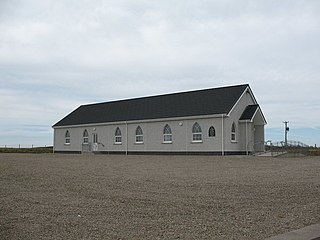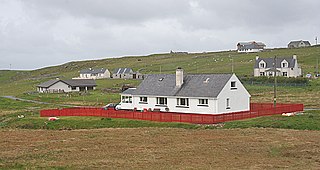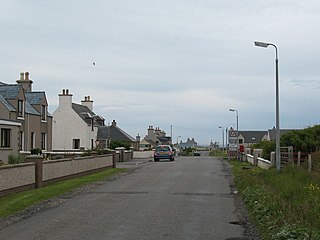
Ness is the northernmost part of the Isle of Lewis, a community consisting of about 16 villages, including Lionel, Habost, Swainbost, Cross, North and South Dell, Cross Skigersta, Skigersta, Eorodale, Adabroc, Port of Ness, Knockaird, Fivepenny and Eoropie. It was the most north-westerly community in the European Union, when the United Kingdom was a member. Its most northerly point is the Butt of Lewis. The name Ness derives from the old Norse for headland and many of the other place names in the area also have a Norse origin.

The Butt of Lewis is the most northerly point of Lewis in the Outer Hebrides. The headland, which lies in the North Atlantic, is frequently battered by heavy swells and storms and is marked by the Butt of Lewis Lighthouse. The nearest populated area is the village of Eoropie, about 1 mile to the south.

Barvas is a settlement, community and civil parish on the Isle of Lewis in Scotland. It developed around a road junction. The A857 and A858 meet at the southern end of Barvas. North is the road to Ness; west takes the traveller to Carloway and the West Side; south runs the road to Stornoway. According to the 2011 Census it still has the highest concentration of Scottish Gaelic speakers in Scotland with 2,037.

Bragar is a village on the west side of the Isle of Lewis in the Outer Hebrides, Scotland, 14 miles from the island's only town, Stornoway. Bragar is within the parish of Barvas, and is situated on the A858 between Carloway and Barvas.

Carloway is a crofting township and a district on the west coast of the Isle of Lewis, in the Outer Hebrides, Scotland. The district has a population of around 500. Carloway township is within the parish of Uig, and is situated on the A858.

Skigersta is a village to the south east of Ness on the Isle of Lewis, in the Outer Hebrides, Scotland. It is the easternmost settlement in the Ness district and is 5km (3miles) southeast of the Butt of Lewis. Skigersta is situated within the parish of Barvas. There is a quay built in 1901 and a shingle beach. The area of Skigersta near the shore is called 'Lachamore'. To the south of Skigersta the moor begins and the road turns into a peat track; there are sheilings on the moor at Cuisiadar and if you follow the moor further south you reach the road at New Tolsta.

Garrabost is a village in the Point peninsula isthmus on the east coast of the Isle of Lewis, in the Outer Hebrides, Scotland. The village is one of the largest in Point, comprising Upper and Lower Garrabost, and Claypark. Garrabost is within the civil parish of Stornoway. The church parish for Point is called Knock, and both Knock Church of Scotland and Knock Free Church of Scotland are located in Garrabost. Garrabost is situated on the A866, between Stornoway and Portnaguran.
Eilean Chaluim Chille is an unpopulated island in the Outer Hebrides.

The Hebrides were settled early on in the settlement of the British Isles, perhaps as early as the Mesolithic era, around 8500–8250 BC, after the climatic conditions improved enough to sustain human settlement. There are examples of structures possibly dating from up to 3000 BC, the finest example being the standing stones at Callanish, but some archaeologists date the site as Bronze Age. Little is known of the people who settled in the Hebrides but they were likely of the same Celtic stock that had settled in the rest of Scotland. Settlements at Northton, Harris, have both Beaker & Neolithic dwelling houses, the oldest in the Western Isles, attesting to the settlement.

Little Bernera is a small island situated off the west coast of the Isle of Lewis in the Outer Hebrides.

Mealista was a township in the west of the Isle of Lewis. It is currently largely uninhabited due to the Highland Clearances, which occurred there in 1838. The beach is a visitor attraction.
Pabay Mòr or Pabaigh Mòr is an uninhabited island in the Outer Hebrides of Scotland.

Borve is a village on the west side of the Isle of Lewis in Scotland, 17 miles from the island's only town, Stornoway.

North Dell is a village on the Isle of Lewis in the community of Ness, in the Outer Hebrides, Scotland. North Dell is within the parish of Barvas. It lies 5 km south of the Butt of Lewis, between the settlements of South Dell and Cross and comprises 22 crofts. North Dell is reputed to be the best village for the growing of potatoes in Lewis – along with Garrabost in Point!

Swainbost is a village on the Isle of Lewis in the district of Ness, in the Outer Hebrides, Scotland. The name Swainbost meaning Sweins steading is of Viking derivation. The settlement is situated in the parish of Barvas. According to Ronald Black, Swainbost was re-settled during the Highland Clearances in 1842. The island's Anglo-Scottish landlord had expected the crofters evicted from Uig to emigrate and only reluctantly granted them land at Swainbost to avert the threat of violence.

Eoropie is the most northerly village on the Isle of Lewis in the parish of Ness, in the Outer Hebrides, Scotland. Eoropie is within the parish of Barvas. The Teampull Mholuaidh is to be found here. Eoropie is situated at the end of the B8013 and B8014 roads, from Lionel and Port of Ness, respectively.

Timsgarry is a village on the Isle of Lewis, in the Outer Hebrides, Scotland. Timsgarry is home to the Baile na Cille Church and the Uig Museum, noted for its giant Chessmen, discovered in the sands in 1831.

Lionel is a village in the Ness area of the Isle of Lewis. Lionel is within the parish of Barvas. Lionel is situated near the northern end of the A857, at the junctions with the B8013 to Eoropie and the B8015 to Eorodale and Skigersta.

James Smith Richardson (1883–1970) was a Scottish architect, antiquarian and archaeologist. He was the first Inspector of Ancient Monuments for Scotland, and was responsible for a series of popular guidebooks to monuments in public care.

South Galson is a settlement on the northwest coast of the Isle of Lewis in the Western Isles of Scotland. It is 11 km southwest of Port of Ness. The Galson Primary School closed in 1996. The populations of North Galson, South Galson, and Melbost were 149 in 1999.




















